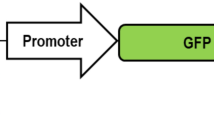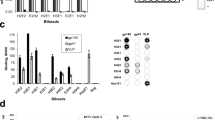Abstract
The availability of rapid and quantitative titration assays for retroviral vectors is important, especially in the context of clinical applications. In this report, we describe a novel assay to titrate lentiviral and gamma retroviral vectors. This rapid assay is based on protein fragment complementation involving the N-terminal (Bla1) and the C-terminal (Bla2) fragments of TEM-1 β-lactamase (BLAK). The Bla1 protein fragment is incorporated in the vector's envelope during vector production. Bla1-bearing vectors are titrated on Bla2-expressing cells. Upon transduction, Bla1 and Bla2 heterodimerize and restore BLAK's enzymatic function. The enzymatic activity of BLAK is quantified by flow cytometry using the green fluorescent CCF2/AM substrate, which is converted into a blue fluorescent product. The enzymatic conversion of the CCF2/AM substrate was found to be directly related to vector entry, as a neutralizing antibody completely blocked the conversion. The titers obtained using this rapid assay correlated well with the titers measured by functional transduction assays. The whole assay can be finished within 8 h. Thus, it is considerably less time consuming compared with other transduction-based titration assays for lentiviral and gamma retroviral vectors.
This is a preview of subscription content, access via your institution
Access options
Subscribe to this journal
Receive 12 print issues and online access
$259.00 per year
only $21.58 per issue
Buy this article
- Purchase on Springer Link
- Instant access to full article PDF
Prices may be subject to local taxes which are calculated during checkout







Similar content being viewed by others
References
Cornetta K, Matheson L, Ballas C . Retroviral vector production in the National Gene Vector Laboratory at Indiana University. Gene Therapy 2005; 12 (Suppl 1): S28–S35.
Lewis PF, Emerman M . Passage through mitosis is required for oncoretroviruses but not for the human immunodeficiency virus. J Virol 1994; 68: 510–516.
Matrai J, Chuah MK, VandenDriessche T . Recent advances in lentiviral vector development and applications. Mol Ther 2010; 18: 477–490.
D’Costa J, Mansfield SG, Humeau LM . Lentiviral vectors in clinical trials: Current status. Curr Opin Mol Ther 2009; 11: 554–564.
Delenda C, Gaillard C . Real-time quantitative PCR for the design of lentiviral vector analytical assays. Gene Therapy 2005; 12 (Suppl 1): S36–S50.
Sastry L, Johnson T, Hobson MJ, Smucker B, Cornetta K . Titering lentiviral vectors: comparison of DNA, RNA and marker expression methods. Gene Therapy 2002; 9: 1155–1162.
Lizee G, Aerts JL, Gonzales MI, Chinnasamy N, Morgan RA, Topalian SL . Real-time quantitative reverse transcriptase-polymerase chain reaction as a method for determining lentiviral vector titers and measuring transgene expression. Hum Gene Ther 2003; 14: 497–507.
Hock RA, Miller AD . Retrovirus-mediated transfer and expression of drug resistance genes in human haematopoietic progenitor cells. Nature 1986; 320: 275–277.
Mavilio F, Ferrari G, Rossini S, Nobili N, Bonini C, Casorati G et al. Peripheral blood lymphocytes as target cells of retroviral vector-mediated gene transfer. Blood 1994; 83: 1988–1997.
Mochizuki H, Schwartz JP, Tanaka K, Brady RO, Reiser J . High-titer human immunodeficiency virus type 1-based vector systems for gene delivery into nondividing cells. J Virol 1998; 72: 8873–8883.
Geraerts M, Willems S, Baekelandt V, Debyser Z, Gijsbers R . Comparison of lentiviral vector titration methods. BMC Biotechnol 2006; 6: 34.
Sanburn N, Cornetta K . Rapid titer determination using quantitative real-time PCR. Gene Therapy 1999; 6: 1340–1345.
Kutner RH, Zhang XY, Reiser J . Production, concentration and titration of pseudotyped HIV-1-based lentiviral vectors. Nat Protoc 2009; 4: 495–505.
Follenzi A, Naldini L . Generation of HIV-1 derived lentiviral vectors. Methods Enzymol 2002; 346: 454–465.
Tonini T, Claudio PP, Giordano A, Romano G . Retroviral and lentiviral vector titration by the analysis of the activity of viral reverse transcriptase. Methods Mol Biol 2004; 285: 155–157.
Galarneau A, Primeau M, Trudeau LE, Michnick SW . Beta-lactamase protein fragment complementation assays as in vivo and in vitro sensors of protein protein interactions. Nat Biotechnol 2002; 20: 619–622.
Rodgers W . Making membranes green: construction and characterization of GFP-fusion proteins targeted to discrete plasma membrane domains. BioTechniques 2002; 32: 1044–1046, 1048, 1050–1041.
Campbell EM, Perez O, Melar M, Hope TJ . Labeling HIV-1 virions with two fluorescent proteins allows identification of virions that have productively entered the target cell. Virology 2007; 360: 286–293.
Zlokarnik G, Negulescu PA, Knapp TE, Mere L, Burres N, Feng L et al. Quantitation of transcription and clonal selection of single living cells with beta-lactamase as reporter. Science 1998; 279: 84–88.
Grunberg R, Ferrar TS, van der Sloot AM, Constante M, Serrano L . Building blocks for protein interaction devices. Nucleic Acids Res 2010; 38: 2645–2662.
O’Doherty U, Swiggard WJ, Malim MH . Human immunodeficiency virus type 1 spinoculation enhances infection through virus binding. J Virol 2000; 74: 10074–10080.
Lefrancois L, Lyles DS . The interaction of antibody with the major surface glycoprotein of vesicular stomatitis virus. I. Analysis of neutralizing epitopes with monoclonal antibodies. Virology 1982; 121: 157–167.
Cavrois M, De Noronha C, Greene WC . A sensitive and specific enzyme-based assay detecting HIV-1 virion fusion in primary T lymphocytes. Nat Biotechnol 2002; 20: 1151–1154.
Yonezawa A, Cavrois M, Greene WC . Studies of ebola virus glycoprotein-mediated entry and fusion by using pseudotyped human immunodeficiency virus type 1 virions: involvement of cytoskeletal proteins and enhancement by tumor necrosis factor alpha. J Virol 2005; 79: 918–926.
Tscherne DM, Manicassamy B, Garcia-Sastre A . An enzymatic virus-like particle assay for sensitive detection of virus entry. J Virol Methods 2010; 163: 336–343.
Manicassamy B, Rong L . Expression of Ebolavirus glycoprotein on the target cells enhances viral entry. Virol J 2009; 6: 75.
Michnick SW, Ear PH, Manderson EN, Remy I, Stefan E . Universal strategies in research and drug discovery based on protein-fragment complementation assays. Nat Rev Drug Discov 2007; 6: 569–582.
Kirkwood TB, Bangham CR . Cycles, chaos, and evolution in virus cultures: a model of defective interfering particles. Proc Natl Acad Sci USA 1994; 91: 8685–8689.
Thomas JA, Ott DE, Gorelick RJ . Efficiency of human immunodeficiency virus type 1 postentry infection processes: evidence against disproportionate numbers of defective virions. J Virol 2007; 81: 4367–4370.
Cronin J, Zhang XY, Reiser J . Altering the tropism of lentiviral vectors through pseudotyping. Curr Gene Ther 2005; 5: 387–398.
Takada T, Iida K, Awaji T, Itoh K, Takahashi R, Shibui A et al. Selective production of transgenic mice using green fluorescent protein as a marker. Nat Biotechnol 1997; 15: 458–461.
Reiser J, Lai Z, Zhang XY, Brady RO . Development of multigene and regulated lentivirus vectors. J Virol 2000; 74: 10589–10599.
Kuroda H, Marino MP, Kutner RH, Reiser J . Production of lentiviral vectors in protein-free media. Curr Protoc Cell Biol 2011; 50: 26.8.1.–26.8.13.
Zhang XY, La Russa VF, Reiser J . Transduction of bone-marrow-derived mesenchymal stem cells by using lentivirus vectors pseudotyped with modified RD114 envelope glycoproteins. J Virol 2004; 78: 1219–1229.
Kuroda H, Kutner RH, Bazan NG, Reiser J . Simplified lentivirus vector production in protein-free media using polyethylenimine-mediated transfection. J Virol Methods 2009; 157: 113–121.
Finer MH, Dull TJ, Qin L, Farson D, Roberts MR . kat: a high-efficiency retroviral transduction system for primary human T lymphocytes. Blood 1994; 83: 43–50.
Chesebro B, Wehrly K, Nishio J, Perryman S . Macrophage-tropic human immunodeficiency virus isolates from different patients exhibit unusual V3 envelope sequence homogeneity in comparison with T-cell-tropic isolates: definition of critical amino acids involved in cell tropism. J Virol 1992; 66: 6547–6554.
Acknowledgements
We are grateful to Dr Douglas S Lyles for providing us with the anti-VSV-G antibody.
Author information
Authors and Affiliations
Corresponding author
Ethics declarations
Competing interests
The authors declare no conflict of interest.
Rights and permissions
About this article
Cite this article
Ou, W., Marino, M., Lu, C. et al. Rapid titration of retroviral vectors using a β-lactamase protein fragment complementation assay. Gene Ther 20, 43–50 (2013). https://doi.org/10.1038/gt.2011.212
Received:
Revised:
Accepted:
Published:
Issue Date:
DOI: https://doi.org/10.1038/gt.2011.212



